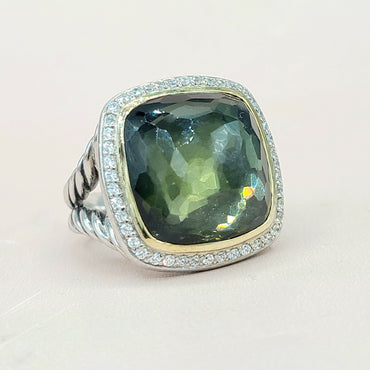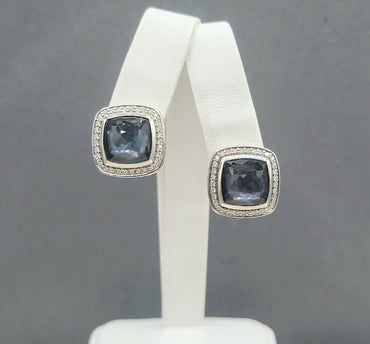
Diamonds and Gemstones: Natural vs. Lab-Grown
Share
Natural vs. Lab-Grown Diamonds and Gemstones: Understanding the Key Differences
When it comes to choosing between natural and lab-grown diamonds and gemstones, many buyers find themselves weighing a variety of factors, including cost, environmental impact, ethical considerations, and aesthetic appeal. Both types of stones can be equally captivating, but their origins and characteristics differ in ways that may influence your decision. This guide will help you navigate the differences and understand why one option might be better suited to your preferences than the other.
Natural Diamonds and Gemstones
1. Origin and Formation
Natural diamonds and gemstones are the result of Earth's geological processes that have been taking place for millions or even billions of years. Natural diamonds are formed deep beneath the Earth's surface under extreme pressure and temperature. Similarly, gemstones like sapphires, emeralds, and rubies are created through intricate mineralogical processes. These stones eventually reach the Earth's surface through volcanic activity or erosion and are extracted via mining.
The fact that natural diamonds and gemstones take eons to form under very specific conditions gives them a mystique that is hard to replicate. Each stone is a natural wonder, shaped by the forces of nature, making them distinct from stones that are grown in laboratories.
2. Rarity and Value
The rarity of natural diamonds and gemstones is a significant factor in their value. Natural diamonds, especially those of superior quality in terms of size, color, and clarity, can be extremely rare, which adds to their desirability and price. Similarly, certain gemstones like Kashmir sapphires, Burmese rubies, and Colombian emeralds are considered incredibly valuable due to their rarity and unique qualities.
This scarcity creates an allure around natural stones that often makes them highly sought after, particularly for engagement rings and other significant pieces of jewelry. Their rarity also leads to a higher investment value, as the supply of natural gemstones and diamonds is finite.
3. Natural Inclusions and Characteristics
A defining feature of natural diamonds and gemstones is their inclusions—tiny imperfections that form within the stone as it develops deep in the Earth. Inclusions can be seen as "fingerprints" of the stone's natural formation process and can enhance its uniqueness. Some inclusions may even increase the value of certain gemstones by providing evidence of their origin, like the presence of unique minerals or crystal structures.
While inclusions may technically be imperfections, many people appreciate them for adding character and authenticity to the stone. Each natural gemstone tells a story through its imperfections, making it a one-of-a-kind piece.
4. Environmental and Ethical Impact
Mining natural diamonds and gemstones has significant environmental and ethical consequences. Mining operations can cause habitat destruction, soil erosion, and pollution. Additionally, the mining of "conflict diamonds" (also known as "blood diamonds") has fueled civil wars, violence, and human rights abuses in certain parts of the world, most notably in Africa.
Though many regulations have been put in place, such as the Kimberley Process, to reduce the trade of conflict diamonds, ethical concerns still surround the mining of natural stones. Buyers who prioritize sustainability and ethical sourcing often look for certifications that ensure the stones they purchase are responsibly mined.
Lab-Grown Diamonds and Gemstones
1. Origin and Formation
Lab-grown diamonds and gemstones are created in highly controlled environments using advanced technology that replicates the natural formation process. Techniques such as High Pressure High Temperature (HPHT) and Chemical Vapor Deposition (CVD) are used to produce diamonds that are chemically, physically, and optically identical to natural diamonds. Similarly, synthetic versions of gemstones like rubies, sapphires, and emeralds are produced in laboratories using methods that simulate natural conditions.
The production of lab-grown stones is much faster and more efficient than the millions of years it takes for natural stones to form, and it can be done without the environmental destruction associated with mining.
2. Cost Efficiency
Lab-grown diamonds and gemstones are generally more affordable than their natural counterparts. The reduced cost comes from the fact that they can be produced quickly and in controlled environments without the extensive labor, transportation, and extraction costs involved in mining natural stones. On average, lab-grown diamonds can be 30-50% less expensive than natural diamonds of the same quality, making them an attractive option for budget-conscious buyers.
Despite their lower cost, lab-grown stones can still offer the same level of beauty, brilliance, and durability as natural stones, providing excellent value for those looking for high-quality jewelry at a more accessible price.
3. Quality and Consistency
One of the main advantages of lab-grown diamonds and gemstones is their consistency. Because they are produced in a controlled environment, lab-grown stones often have fewer inclusions and more consistent color and clarity compared to natural stones. This means buyers are more likely to find flawless or near-flawless options among lab-grown gemstones.
For buyers seeking perfection in a stone's appearance—whether in terms of brilliance, clarity, or uniformity—lab-grown diamonds and gemstones offer a level of precision that can be difficult to find in nature.
4. Ethical and Environmental Considerations
Lab-grown diamonds and gemstones are often viewed as the more ethical and environmentally friendly choice. Because they are created in labs, there is no need for mining, which eliminates the negative environmental impact typically associated with the extraction of natural stones. Furthermore, lab-grown stones are free from the ethical concerns related to conflict diamonds or exploitative labor practices.
For consumers who prioritize sustainability, lab-grown gemstones offer the peace of mind that their purchase did not contribute to environmental degradation or human suffering.
How to Differentiate Between Natural and Lab-Grown Stones
Because lab-grown diamonds and gemstones are virtually indistinguishable from natural ones to the naked eye, identifying whether a stone is natural or lab-grown often requires professional evaluation. Here are some key methods for telling them apart:
1. Gemological Testing
A certified gemologist can use specialized equipment to examine the stone's internal structure, composition, and formation patterns. This is one of the most reliable ways to determine whether a stone is natural or lab-grown.
2. Inclusions and Growth Patterns
Natural stones typically have inclusions and growth patterns that reflect their geological origins, while lab-grown stones may exhibit telltale signs like curved growth lines or the presence of metallic inclusions, which are less common in natural stones.
3. UV Light Test
Some lab-grown diamonds display fluorescence under ultraviolet light, which can help distinguish them from natural diamonds. However, this is not a definitive test, as not all lab-grown stones exhibit this trait.
4. Price Comparison
If a high-quality diamond or gemstone seems significantly less expensive than expected, it may be lab-grown. The lower cost of production often translates to a more affordable retail price for lab-grown stones.
5. Certification and Documentation
Reputable sellers provide certification for diamonds and gemstones, detailing whether they are natural or lab-grown. Certificates from trusted organizations like the Gemological Institute of America (GIA) or the International Gemological Institute (IGI) will clarify the stone's origin.
Final Thoughts
Ultimately, the decision between natural and lab-grown diamonds and gemstones comes down to your personal values, budget, and aesthetic preferences. Both options have their own distinct advantages: natural stones offer rarity, tradition, and unique imperfections that tell a story, while lab-grown stones provide ethical sourcing, affordability, and consistency in quality.
If you prioritize sustainability and ethical considerations, lab-grown diamonds and gemstones are a compelling option. If you appreciate the timeless appeal and natural beauty of Earth's creations, natural stones will offer a sense of history and rarity that is hard to replicate. Either way, you're choosing a piece of beauty and brilliance that suits your values and lifestyle.




